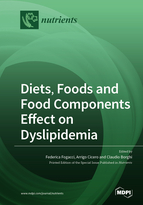Diets, Foods and Food Components Effect on Dyslipidemia
A special issue of Nutrients (ISSN 2072-6643). This special issue belongs to the section "Lipids".
Deadline for manuscript submissions: closed (30 September 2020) | Viewed by 131697
Special Issue Editors
Interests: Cholesterol; Cardiovascular risk factors; Nutrition; Nutraceuticals
Special Issues, Collections and Topics in MDPI journals
Interests: nutraceuticals; nutrition; cholesterol; hypertension; uric acid; cardiovascular risk factors
Special Issues, Collections and Topics in MDPI journals
Interests: cholesterol; hypertension; uric acid; cardiovascular risk factors; cardiovascular prevention
Special Issues, Collections and Topics in MDPI journals
Special Issue Information
Dear Colleagues,
Hypercholesterolemia is an independent risk factor for cardiovascular disease and a recognized target of pharmacological therapeutic agents in both primary and secondary prevention. However, there is increasing interest for the use of natural lipid-lowering compounds that may delay or circumvent drug therapy.
To date, there is a strong evidence showing that dietary factors are able to influence atherogenesis. In particular, the Mediterranean diet is particularly rich in vegetable active compounds contributing to its positive effect on human health.
In this Special Issue, we invite investigators to contribute original research articles reporting data from both experimental and clinical studies as well as review articles that provide evidence of the effect of food, diet, and dietary components on dyslipidemia.
Dr. Federica Fogacci
Prof. Arrigo Cicero
Prof. Claudio Borghi
Guest Editors
Manuscript Submission Information
Manuscripts should be submitted online at www.mdpi.com by registering and logging in to this website. Once you are registered, click here to go to the submission form. Manuscripts can be submitted until the deadline. All submissions that pass pre-check are peer-reviewed. Accepted papers will be published continuously in the journal (as soon as accepted) and will be listed together on the special issue website. Research articles, review articles as well as short communications are invited. For planned papers, a title and short abstract (about 100 words) can be sent to the Editorial Office for announcement on this website.
Submitted manuscripts should not have been published previously, nor be under consideration for publication elsewhere (except conference proceedings papers). All manuscripts are thoroughly refereed through a single-blind peer-review process. A guide for authors and other relevant information for submission of manuscripts is available on the Instructions for Authors page. Nutrients is an international peer-reviewed open access semimonthly journal published by MDPI.
Please visit the Instructions for Authors page before submitting a manuscript. The Article Processing Charge (APC) for publication in this open access journal is 2900 CHF (Swiss Francs). Submitted papers should be well formatted and use good English. Authors may use MDPI's English editing service prior to publication or during author revisions.
Keywords
- Dyslipidemia
- Lipidomics
- Reverse cholesterol transport
- Nutrition
- Macronutrients
- Micronutrients
- Nuts
- Polyphenols
- Bioactive peptides
- Fibers
- Beta-glucans
- Plant sterols and stanols
- Vegetable oils
- Soy and lupin









